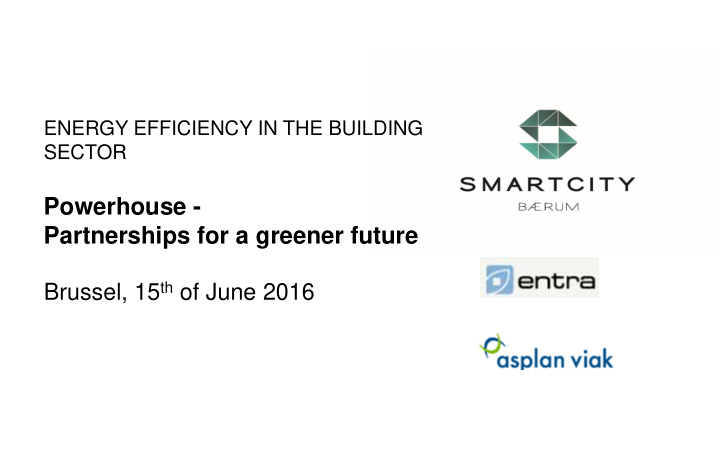



ENERGY EFFICIENCY IN THE BUILDING SECTOR Powerhouse - Partnerships for a greener future Brussel, 15 th of June 2016
- A partnership between the municipality and the private sector in Bærum. - The goal is to reduce energy use and greenhouse gas emissions through joint projects and co-operation. - The solutions must be attractive in a way that makes citizens want to use them.
Vision - Profitable interaction for a greener future
SmartTransport SmartEnergy SmartGovernance
Some projects Carpooling Smart Cycling Hamang Parking challenge - Big Data Powerhouse City Bikes Hydrogen Fornebu Car sharing Smart EV’s Traveling
Dag Christer Øverland Property Developer 6
This is Entra ASA -Norway • Leading property company in Norway engaged in developing, letting and operating attractive and environmentally sustainable buildings • 1.2 million square metres divided between 110 buildings. 90% office properties Side 7
40% Buildings account for 40% of the world`s energy consumption
It is not sufficient to focus on new construction and refurbishment alone: Percentage newbuildings 1,5% Percentage refurbishment 1,5 % Side 9
Entra`s environmental working: • 1. Daily reduction of energy in all buildings • 2. Total refurbishment of the oldest buildings • 3. New green buildings Side 10
1. Daily reduction of energy in Entra`s existing buildings • Switching to LED light bulbs • Upgrading central processing system (SD- anlegg) • New heat recovers (Varmegjenvinnere) • Reduction of operating time: - ventilation - light - heating - cooling Average reduction of 82 kilowatts pr.m2 gives 82 million kw/m2 in total each year. Side 11
2. Total refurbishment of the oldest buildings 12
Urban Mountain, Oslo Technical data: Area: 77,000 m2 Energy consumption: 60 kWh / m2 / year Former energy: 258 kWh / m2 / year Sustainability: Passivehouse FutureBuilt BREEAM NOR - Outstanding Energy Class A Cradle2Cradle
3. New green buildings OsloSolar Technical data: Area: 55000 m2 Energy consumption: -5,8 kWh / m2 / year Former energy: Sustainability: Plus house FutureBuilt BREEAM NOR -Outstanding Energy Class A Cradle2Cradle (C2C)
8500 m2 Photovoltaics (PV) to the south
Form follows enviroment: We shape the building so it can produce as much energy as possible.
Future Buildings COMMUNICATION bicycle parking 10 500 0 parking spaces charging for stations for conventional electric vehicles cars
VISION OSLOSOLAR: The world's most environmentally friendly urban building - that's gives back to the environment and to the city's population.
Powerhouse - Partnerships for a greener future Peter Bernhard Senior Consultant - Energy and Environment Asplan Viak AS, Norway Brussel, 15. June 2016
INTERDISCIPLINARY ARCHITECTURE AND CONSULTING COMPANY Appr. 900 persons with expertise in: • Architecture • City and Area Planning • Building and Construction • Energy and Environment • Geographic Information Systems and IT Visualisation • Landscape Architecture • Communication and Transport Engineering • Social Analysis and Evaluation • Community Planning • Technical Infrastructure • Water Supply and Environmental Engineering
The Powerhouse collaboration «Nobody can develop a Powerhouse plus energy building alone – but together with our partners we can do it.» .
Process and Methodology New collaboration models with emphasis on interdisciplinary collaboration – Integrated Design Process Cooperation between all disciplines from day one It has been essential for the team to work towards a clear defined goal Broad communication of the energy and environmental goals Ambitious leadership Dare to take risks and try new solutions
Definition of a Powerhouse A Powerhouse is a building that during it’s lifecycle produces more renewable energy than it consumes for production of building materials, construction, operation and demolition of the building. Additional criterias: • The quality of produced energy should not be lower than bought energy • Minimum passivehouse level (NS 3701) • Appliances (PC, printers etc.) not included in the energy balance • Embodied energy over the buildings lifecycle to be calculated in primary energy • Shall be built within commercial market conditions 24
Powerhouse Kjørbo Two office buildings Originally built: early 1980’s Area: 5,180 m 2 total Project start: January 2012 Completed: April 2014 Objectives Keep the expression of the building Renovate to an energy positive building (energy use for appliances not included in the energy budget) Build within commercial market conditions BREEAM-NOR «Outstanding» – the highest of the five levels of this environmental classification system
before …
….after
before …
…and after …and after Example: Activity Based Workspace (ABW)
Energy concept Consequent reduction of energy demand Exposed concrete in ceiling for heat storage Energy wells supply heat and free cooling. Recycling of heat from server room. Two heat pumps operating at different temperatures. Local production of electricity
Energy performance Energy label A Building code 2010 Energy label C Before renovation - average Norwegian office building
Minimize embodied energy - Materials The buildings’ structural systems remained Materials such as old glass façades have been reused All new materials were carefully chosen to ensure that the materials had low embodied energy.
Energy dash board – Solar production and energy consumption 1. Jan - 11. June 2016
Hydrogen fuel station - PV-powered
Powerhouse Brattørkaia, Trondheim New office building 13.000 m 2 Appr. 500 workplaces
More information about Powerhouse Kjørbo Brochure in English can be downloaded from http://www.powerhouse.no/en/prosjekter/kjorbo / Video in English: https://www.youtube.com/embed/JGYu1lp5tu 0
Thank you for your attention ! ! «Powerhouse Kjørbo is most likely the most energy efficient renovated building in the world» Mats Mysen, senior researcher at SINTEF Building and Infrastructure Source: Fremtidens Byggenæring - 13 Asplan Viak AS www.asplanviak.no pb@asplanviak.no +47-4040762
Recommend
More recommend